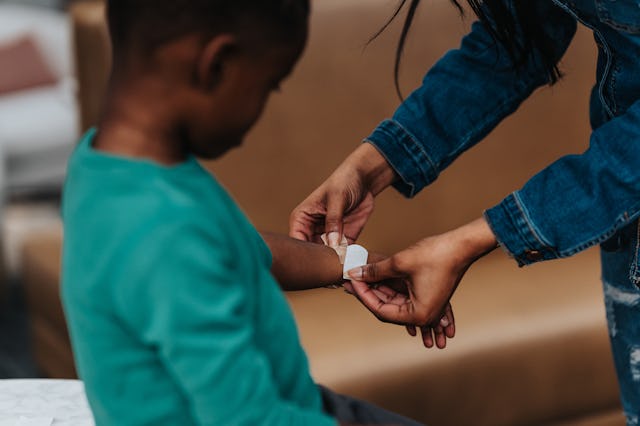How Plastic Surgeons Treat Their Kids’ Cuts & Scrapes To Prevent Scarring
They’ll still be the cutest, scars or not, but it’s natural to want to help them heal.

We’ve all been there — your kid completely eats it and stands up with a scrape or gash on their face. Oh God, please don’t let that scar, you think. Or maybe your little one is constantly banging up their knees or elbows, and you’re not sure how much more their skin could possibly take. Whether your child just plays rough, has had a major injury, or has gone through surgery, it’s natural to want their boo-boos to heal as perfectly as possible. So, here’s how to prevent scarring from cuts and scrapes, according to plastic surgeons who specialize in that sort of thing (and are parents themselves).
When your kids get cuts and scrapes, what do you do to help them heal and prevent scarring?
For starters, you want to clean it the right way, says Dr. Angela Sturm, a double board-certified facial plastic surgeon.
“When my kids get cuts and scrapes, I wash with soap and water, not peroxide, to clean the area. Pat dry and use an antibiotic occlusive ointment like Bacitracin. Peroxide does not promote quick healing and is uncomfortable for the kids. After a couple of days on Bacitracin, I switch them to a bland occlusive ointment. I love the Alastin Soothe and Protect Recovery Balm. That’s my go-to for big and small boo-boos. Aquaphor is also great.”
Why all the ointment, you ask? “Try to keep them moisturized with ointments to keep from getting a scab for best healing. The best you can, try to keep them from picking at it with fun Band-Aids! My kids have a whole collection,” she says.
If you’re dealing with a cut rather than a scrape, the depth of the wound will determine the best steps. “Skin glue can be good for superficial cuts. Deeper cuts need stitches followed by a Band-Aid, Steri-Strip, or antibiotic ointment. Sometimes dissolving sutures work in very young children; otherwise, sutures are removed after five to seven days, depending on the area,” says Dr. Joshua Korman, board-certified plastic surgeon and founder of Korman Plastic Surgery, based in Northern California.
If you’re unsure whether a cut requires more medical care than you can provide at home, snap a picture and send it to your pediatrician. It’s always worth getting a second opinion, especially if you’re particularly worried about preventing scarring, Korman says.
If your child gets a scar, what can you do to help lighten it?
The answer is, it depends. You need to consider the scar you’re working with: Is it new or old? Smooth, bumpy, flat, or hypertrophic? Is it dark or light in color? Avoiding sun exposure and wearing SPF plays a major role in preventing scarring when a wound is healed, Korman says. For those who already have a scar, steroid injections may also help lighten and flatten some marks.
In many cases, though, you may not need to do much at all, Sturm says. “Most kids heal really well on their own. As much as it hurts our hearts not to do something to help, time does a lot. Scars in kids may be more red or brown initially, but then fade. The most important thing you can do is to have it evaluated by a physician at the time of the injury to see if you need stitches. The second thing is sunscreen and sun avoidance. I’m much more conservative with kids' scars compared to adults when it comes to creams and treatments.”
What products do you use to prevent scarring and promote healing?
Korman recommends Biafin, which he says was originally developed by a French chemist to heal the burns of his daughter-in-law, who was a model for Yves Saint Laurent.
“I heard about this from a deep plane facelift patient of mine from France, who healed incredibly fast. I have found it can really get the red out of new scars in about three weeks. It hydrates and promotes healing. I recommend massaging it into your scars twice daily. Biafin is especially good for new scars, and can work on small or large areas. It can be used on children as long as they are not allergic to its ingredients, but not on babies younger than 1 to 2 months,” he says.
Sturm says some over-the-counter scar creams are effective, but they need a key ingredient. “Scar creams with silicone in the ingredients help keep the scar moisturized and heal better. Also, if you can get them to wear silicone strips at night, it’s helpful. They look like Band-Aids and are easy to apply. I don’t see as much benefit with creams that don’t contain silicone, like Mederma.”
So, while you can’t prevent scrapes, cuts, and boo-boos of all sorts, there are some steps you can take to keep scars at bay for your kids.